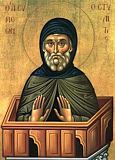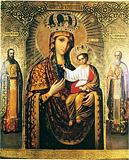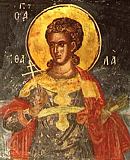

| Previous day | Next day |
| Old Style
September 1
|
Monday |
New Style
September 14
|
| 15th Week after Pentecost. Tone 5. | No fast.
|
![]() Church New Year
Church New Year ![]() St. Symeon Stylites (the Elder) (459) and his mother St. Martha (428).
St. Symeon Stylites (the Elder) (459) and his mother St. Martha (428).
Righteous Joshua the Son of Nun (ca. 1400 b.c.). Martyr Aeithalas of Persia (380). Holy 40 Women Martyrs: Laurencia (deaconess), Celsina, Theoclia, Theoctista, Dorothy, Eutychia, Thecla, Aristaineta, Philadelphia, Mary, Veronica, Euthymia, Lamprotatia, Euphymia, Theodora, Theodota, Teteia, Aquilina, Theodulia, Aplodora, Lampadia, Procopia, Paula, Junilla, Ampliana, Percissa, Polynicia, Maura, Gregoria, Cyria, Bassa, Callinica, Barbara, Cyriacia, Agathonica, Justa, Irene, Timothea, Tatiana, and Anna, and Hieromartyr Ammon (deacon), their teacher, at Heraclea in Thrace (321-323). Martyrs Callista and her brothers Evodus and Hermogenes, at Nicomedia (309). St. Dionysius Exiguus, monk, of Rome (ca. 545). St. Anthony (Abashidze), metropolitan of Tauride and Simferapol (1921).
Synaxis of the Most Holy Theotokos in Miasena Monastery, in commemoration of the discovery of her icon (864). Icons of the Most Holy Theotokos: “Chernigov-Gethsemane,” (1869) “Of Alexandria,” “Avgustovskaya,” (1914) and “All-blessed One” (Kazan).
St. Verena of Zurzach (Switzerland) (ca. 350). Commemoration of the Great Fire at Constantinople (ca. 470). St. Giles (Aegidius), monastic founder, along the Rhone (ca. 712). St. Meletius the Younger, of Thebes (1095-1124). St. Nicholas of Courtaliatis on Crete, monk (1670). New Martyr Angelis of Constantinople (1680). St. Haido of Stanos (1820-1821). St. Symeon of Lesbos.
Repose of Hieromonk Sofian (Boghiu) of Romania (2002).
Thoughts for Each Day of the Year
According to the Daily Church Readings from the Word of God
By St. Theophan the Recluse

Thursday. [Eph. 5:33-36; Luke 4:16-22]
The Lord did not only come to preach the acceptable year, but He brought it as well. Where is it? In the souls of believers. The earth will never become paradise under the current state of affairs; but it is and will be an arena of preparation for the heavenly life. The rudiments of heavenly life are placed in the soul, the possibility for it lies in God’s grace, while grace was brought by our Lord Jesus Christ—who brought, consequently, the acceptable year for souls. He who listens to the Lord and fulfils all that is commanded by Him, receives grace, and with its power enjoys the acceptable year within himself. This truly occurs in all who sincerely believe and act according to faith. You will not fill your soul with this acceptableness by thinking; you must act, and it will enter in on its own. There might not be any outer peace, just inner, and yet it cannot be separated from Christ. But it always happens that as soon as inner peace is established, outer disturbances are neither bitter nor heavy. Thus, this aspect is also acceptable—it only seem like a cold winter on the outside.
Articles
 Church New YearThe first day of the Church New Year is also called the beginning of the Indiction. The term Indiction comes from a Latin word meaning, “to impose.” |
 Martyr Aithalas of PersiaThe Holy Martyr Aithalas the Deacon, by order of the Persian emperor Sapor II, was put to death by stoning in the year 380 for confessing Christ. |








